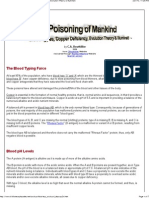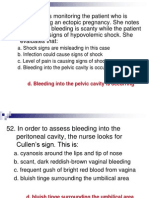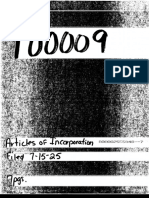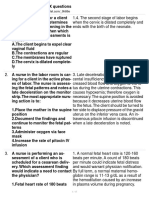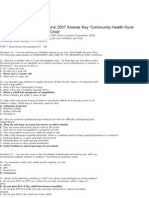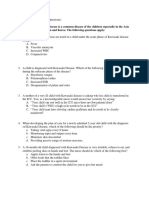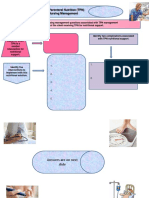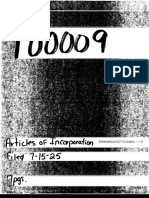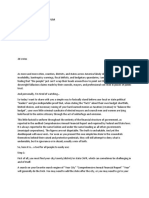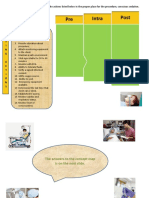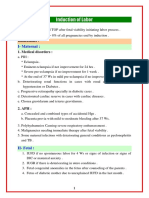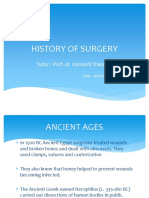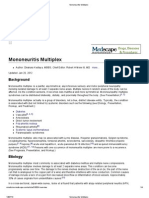NCLEX Questions OB Questions
NCLEX Questions OB Questions
Uploaded by
Alvin L. RozierCopyright:
Available Formats
NCLEX Questions OB Questions
NCLEX Questions OB Questions
Uploaded by
Alvin L. RozierOriginal Description:
Copyright
Available Formats
Share this document
Did you find this document useful?
Is this content inappropriate?
Copyright:
Available Formats
NCLEX Questions OB Questions
NCLEX Questions OB Questions
Uploaded by
Alvin L. RozierCopyright:
Available Formats
OB NCLEX Questions
Alvin L. Rozier
1. A client with pregnancy-induced hypertension (PIH) receives magnesium sulfate, 4 g in 50% solution I.V. over 20 minutes. What is the purpose of administering magnesium sulfate to this client. a. to lower blood pressure b. to prevent seizures c. to inhibit labor d. to block dopamine receptors B. Mag sulfate is given to prevent and control seizures in clients with PIG. Mag sulfate has no effect on labor or dopamine receptors.
Initial client assessment information includes: 2. BP - 160/110 mmHg, Pulse - 88 bpm, RR - 22 bpm, reflexes +3/+4 w/ 2 beat clonus. Urine specimen reveals +3 negative sugar, & ketones. Based on these findings, the nurse would expect the client to have which complaints? a. headache, blurred vision, facial and extremity swelling b. abdominal pain, urinary frequency, and pedal edema c. diaphoresis, nystagmus, and dizziness d. lethargy, chest pain, and SOB A. headache, blurred vision, and facial and extremity swelling. 3. Which of the following is the most serious adverse affect associated with oxytocin administration during labor? a. tetanic contractions b. elevated blood pressure c. early decelerations of FHR d. water intoxication A. tetanic contractions - are most serious adverse effect associated with oxytocin. When tetanic contractions occur, the fetus is at high risk for hypoxia and the mother is at risk for uterine rupture
OB NCLEX Questions
Alvin L. Rozier
4. A client in labor receives epidural anesthesia. The nurse should assess carefully for which adverse reaction to the anesthetic agent? a. hypotensive crisis b. fetal tachycardia c. renal toxicity d. increased beat-to-beat variability in the FHR
5. Hypotensive crisis - may occur after epidural anesthesia administration as the anesthetic agent spreads through the spinal canal, blocking sympathetic innervations.A client is in the second stage of labor. during this stage, how frequently should the nurse assess her uterine contractions? a. every 5 minutes b. every 15 minutes c. every 30 minutes d. every 60 minutes B. every 15 minutes
6. The cervix is not completely dilated and the client has a strong urge to push. The nurse-midwife tells her not to push yet. What is the rationale for this instruction?
a. early pushing may cause edema and impede fetal descent b. the nurse-midwife isn't ready to assist her c. the fetus hasn't rotated into the proper position d. pushing at this time may cause rupture of the membranes
A. Pushing bfore the cervix is completely dilated may cause edema and tissue damage and may impede fetal descent.
OB NCLEX Questions
Alvin L. Rozier
7. The gonorrhea culture is positive in a pregnant mom. What is the significance of this finding? a. may cause neural tube defect in fetus b. may cause an eye infection in the neonate c. may cause acute liver changes in the fetusd. may cause anemia in neonate d. may cause anemia in neonate B. gonorrhea in the cervix may cause neonatal eye infection during delivery 8. In the 1st stage of labor, a client with a full-term pregnancy has an electronic fetal monitor (EFM) in place. Which EFM pattern suggests adequate uteroplacental-fetal perfusion? a. persistent fetal bradycardia b. variable decelerations c. average variability d. late decelerations B. average variability - 6 to 10 bpm accurately predicts adequate uteroplacental-fetal perfusion. Persistant bradycardia may indicate hypoxia, arrhythmias, or umbilical cord compression. Variable decelerations suggest umbilical cord compression. Late decelerations may reflect decreased blood flow and oxygen to the intervillous spaces during contractions. 9. The physician orders I.V. administration of oxytocin. Why must the nurse monitor the client's fluid intake and output closely during oxytocin administration? a. oxytocin is toxic to the kidneys b. oxytocin causes excessive thirst c. oxytocin causes water intoxication d. oxytocin has a diuretic effect C. the nurse should monistor I/Os b/c prolonged oxytocin infusion may
OB NCLEX Questions
Alvin L. Rozier
cause severe water intoxication, leading to seizures, coma, and death 10. What condition would place the client at risk for
disseminated intravascular coagulation? (DIC)
a. intrauterine fetal death b. placenta accreta c. dysfunctional labor d. premature rupture of the membranes A. Intrauterine fetal death, abruptio placentae, septic shock, and amniotic fluid embolism may trigger normal clotting mechanisms; if clotting factors are depleted, DIC may occur.
You might also like
- Salso Manual 2018Document124 pagesSalso Manual 2018Sana Anam Jahan100% (1)
- Practice Exam 2 OB NursingDocument21 pagesPractice Exam 2 OB NursingSpurgis Rickard91% (22)
- Maternity Nursing NCLEX Practice Quiz and Test Bank (500+ Questions)Document1 pageMaternity Nursing NCLEX Practice Quiz and Test Bank (500+ Questions)regine onalNo ratings yet
- The Chicago Review Press NCLEX-RN Practice Test and ReviewFrom EverandThe Chicago Review Press NCLEX-RN Practice Test and ReviewRating: 4 out of 5 stars4/5 (20)
- Poisoning of Mankind - The Fallacy of Blood Types & Copper DeficiencyDocument7 pagesPoisoning of Mankind - The Fallacy of Blood Types & Copper DeficiencyAlvin L. Rozier100% (3)
- The Pharmacist Guide To Implementing Pharmaceutical Care PDFDocument502 pagesThe Pharmacist Guide To Implementing Pharmaceutical Care PDFLuis Sosa100% (1)
- OB Power Point Presentation 002Document57 pagesOB Power Point Presentation 002RitamariaNo ratings yet
- NCLEX Sample Questions For Maternal and Child Health Nursing 2Document17 pagesNCLEX Sample Questions For Maternal and Child Health Nursing 2Rose Dacles100% (4)
- Maternity Nursing EXAM REVIEWDocument8 pagesMaternity Nursing EXAM REVIEWJulienne Sanchez-Salazar100% (4)
- Maternal and Child Health Pracice Test 1-2-3Document84 pagesMaternal and Child Health Pracice Test 1-2-3chuppepay100% (1)
- Maternal QuizDocument3 pagesMaternal QuizJeffrey ViernesNo ratings yet
- Nclex Questions - Pediatric NursingDocument8 pagesNclex Questions - Pediatric NursingAngelique Ramos Pascua100% (1)
- Maternity Nursing ObDocument11 pagesMaternity Nursing ObMayls Sevilla Calizo75% (20)
- NCLEX Questions and AnswersDocument16 pagesNCLEX Questions and AnswersJoslyn Gross100% (3)
- Obstetrical Nursing Practice ExamDocument11 pagesObstetrical Nursing Practice Examstuffednurse83% (12)
- NCLEX Review of Maternity NursingDocument34 pagesNCLEX Review of Maternity NursingAlain Chery100% (2)
- 2020 NCLEX-PN Test Prep. Questions and Answers with Explanations: Study Guide to Pass the License Exam Effortlessly - Exam Review for Practical NursesFrom Everand2020 NCLEX-PN Test Prep. Questions and Answers with Explanations: Study Guide to Pass the License Exam Effortlessly - Exam Review for Practical NursesRating: 1 out of 5 stars1/5 (1)
- 2018 NCLEX-PN Test Prep. Questions and Answers with Explanations: Study Guide to Pass the License Exam Effortlessly - Exam Review for Practical NursesFrom Everand2018 NCLEX-PN Test Prep. Questions and Answers with Explanations: Study Guide to Pass the License Exam Effortlessly - Exam Review for Practical NursesRating: 4.5 out of 5 stars4.5/5 (2)
- Articles of Incorporation of U S Corp Company PDFDocument7 pagesArticles of Incorporation of U S Corp Company PDFAlvin L. RozierNo ratings yet
- NCLEX 3 HepatitisDocument7 pagesNCLEX 3 HepatitisAlvin L. Rozier100% (1)
- Books1 PDFDocument559 pagesBooks1 PDFFarook Seikh0% (6)
- GE Corometrix 250cx Monitor - User ManualDocument250 pagesGE Corometrix 250cx Monitor - User ManualmanualslibNo ratings yet
- AtlasDocument56 pagesAtlasKolea HanganuNo ratings yet
- Post-Partum Review Questions - Handout 2 With Answers /rationalesDocument9 pagesPost-Partum Review Questions - Handout 2 With Answers /rationalesnkuligowski100% (2)
- Hesi MaternityDocument20 pagesHesi Maternityracquela_367% (3)
- Nclex MCN IntrapartumDocument17 pagesNclex MCN IntrapartumMary Chris C. GOMEZNo ratings yet
- RPN Post Review TestDocument69 pagesRPN Post Review Testfairwoods94% (17)
- Nclex Question ExamplesDocument4 pagesNclex Question Examplesmissy23pap100% (1)
- Maternity NursingDocument24 pagesMaternity NursingJen Arcillas Tuble - Iledan100% (1)
- Fundamentals of Nursing NCLEX Practice Questions Quiz 2Document41 pagesFundamentals of Nursing NCLEX Practice Questions Quiz 2Regine Mae Encinada100% (1)
- Nclex Questions - Medical Surgical NursingDocument15 pagesNclex Questions - Medical Surgical NursingRegine Gozo100% (1)
- OB COMPRE PRELIM 2019 Key 1Document27 pagesOB COMPRE PRELIM 2019 Key 1Zhy Caluza57% (7)
- Ob Post Test NclexDocument11 pagesOb Post Test NclexNazkie Alganion100% (4)
- ExamDocument33 pagesExamRhiza Pagdanganan100% (1)
- NCLEX Exam Cardiovascular Surgery CareDocument5 pagesNCLEX Exam Cardiovascular Surgery CareHeather ClemonsNo ratings yet
- Ob 1Document13 pagesOb 1iandame100% (1)
- Maternity QuestionsDocument49 pagesMaternity Questionsdeb100% (17)
- 300 Items QuestionnaireDocument62 pages300 Items Questionnairestuffednurse100% (5)
- Practice Quiz - Maternity & NewbornDocument4 pagesPractice Quiz - Maternity & NewbornMS100% (2)
- Basic Care and Comfort NCLEX Practice TestDocument7 pagesBasic Care and Comfort NCLEX Practice TestChristelle Brookshiel Demayo MarbaNo ratings yet
- MCN DX Test 2010Document9 pagesMCN DX Test 2010jjbautista100% (2)
- NCLEX Exam Obstetrical Nursing - Antepartum (50 Items)Document13 pagesNCLEX Exam Obstetrical Nursing - Antepartum (50 Items)Catherine Manalo100% (1)
- Maternity Nursing Part 1Document22 pagesMaternity Nursing Part 1iko55200075% (4)
- MATERNALDocument32 pagesMATERNALsean blaze100% (1)
- Med Surg QuestionsDocument62 pagesMed Surg QuestionsClarissa LurisseNo ratings yet
- Nurseslabs Maternity Nursing Q OnlyDocument6 pagesNurseslabs Maternity Nursing Q OnlyCharles Malcolm Dalugdug100% (1)
- Maternal in ChildDocument15 pagesMaternal in ChildRenalyn VillasencioNo ratings yet
- Maternal and Child Nursing 3Document15 pagesMaternal and Child Nursing 3gellie100% (1)
- OB Nursing Test QuestionsDocument15 pagesOB Nursing Test QuestionsAileen Orjaliza Babanto100% (5)
- Nursing Board Exam Test Drill 3Document2 pagesNursing Board Exam Test Drill 3Kira100% (15)
- Pre TestDocument4 pagesPre TestEnzoNo ratings yet
- 4 Ob ExamDocument9 pages4 Ob ExamKim Ramos100% (1)
- Pediatric Nursing QuestionsDocument8 pagesPediatric Nursing QuestionsLouie A. Gallego50% (2)
- 100 Item Comprehensive Exam II With Answers and RationaleDocument16 pages100 Item Comprehensive Exam II With Answers and RationaleChieChay Dub100% (3)
- Maternal & Child NursingDocument15 pagesMaternal & Child NursingLilian Flores100% (2)
- Gastrointestinal QuestionsDocument6 pagesGastrointestinal Questionsbibs_caigas3744100% (4)
- PEDIATRICS NursingDocument5 pagesPEDIATRICS NursingAndrea Franchesca DelaCruz DescalzoNo ratings yet
- Chicago Review Press NCLEX-PN Practice Test and ReviewFrom EverandChicago Review Press NCLEX-PN Practice Test and ReviewRating: 4 out of 5 stars4/5 (4)
- NATIONAL COUNCIL LICENSURE EXAMINATION FOR REGISTERED NURSES (NCLEX-RN): Passbooks Study GuideFrom EverandNATIONAL COUNCIL LICENSURE EXAMINATION FOR REGISTERED NURSES (NCLEX-RN): Passbooks Study GuideNo ratings yet
- COMPREHENSIVE NURSING ACHIEVEMENT TEST (RN): Passbooks Study GuideFrom EverandCOMPREHENSIVE NURSING ACHIEVEMENT TEST (RN): Passbooks Study GuideNo ratings yet
- 2017 NCLEX-RN Test Prep Questions and Answers with Explanations: Study Guide to Pass the License Exam EffortlesslyFrom Everand2017 NCLEX-RN Test Prep Questions and Answers with Explanations: Study Guide to Pass the License Exam EffortlesslyRating: 4 out of 5 stars4/5 (18)
- Maternal Exam CIDocument9 pagesMaternal Exam CIRyojie RetomaNo ratings yet
- Us Bankruptcy and The Moors Part2Document5 pagesUs Bankruptcy and The Moors Part2Alvin L. Rozier100% (1)
- TPN Concept 2 MapDocument3 pagesTPN Concept 2 MapAlvin L. RozierNo ratings yet
- Pressure Ulcer Concept MapDocument3 pagesPressure Ulcer Concept MapAlvin L. RozierNo ratings yet
- Articles of Incorporation of U S Corp Company PDFDocument7 pagesArticles of Incorporation of U S Corp Company PDFAlvin L. RozierNo ratings yet
- The CAFR Scam in Every CityDocument12 pagesThe CAFR Scam in Every CityAlvin L. RozierNo ratings yet
- Sedation Concept Map 2 PDFDocument3 pagesSedation Concept Map 2 PDFAlvin L. RozierNo ratings yet
- Pediatric RemediationDocument5 pagesPediatric RemediationAlvin L. Rozier67% (3)
- Mental Health RemediationDocument3 pagesMental Health RemediationAlvin L. Rozier100% (2)
- Newborn Packet (100 Points) (5 Points)Document2 pagesNewborn Packet (100 Points) (5 Points)Alvin L. RozierNo ratings yet
- Sedation Concept Map 2Document3 pagesSedation Concept Map 2Alvin L. RozierNo ratings yet
- Misc Review QsDocument4 pagesMisc Review QsAlvin L. RozierNo ratings yet
- Running Head: EMERGENCY CESAREAN 1Document6 pagesRunning Head: EMERGENCY CESAREAN 1Alvin L. RozierNo ratings yet
- Safety Infection Control Review QsDocument3 pagesSafety Infection Control Review QsAlvin L. RozierNo ratings yet
- Learning Contract Template-2Document4 pagesLearning Contract Template-2Alvin L. RozierNo ratings yet
- Concept Care Map UCOB#1Document1 pageConcept Care Map UCOB#1Alvin L. RozierNo ratings yet
- Orthopaedic Cast and BracesDocument21 pagesOrthopaedic Cast and BracesAlvin L. RozierNo ratings yet
- Arguments Against Stem Cell UseDocument4 pagesArguments Against Stem Cell UseAlvin L. RozierNo ratings yet
- Biology of Melanocytes: Done By: Mohammed Abduljabbar Done By: Mohammed Abduljabbar KauhDocument66 pagesBiology of Melanocytes: Done By: Mohammed Abduljabbar Done By: Mohammed Abduljabbar Kauhmoon1312No ratings yet
- Cervical Spine InjuriesDocument50 pagesCervical Spine InjuriesgamalramadiNo ratings yet
- L7 - Induction of LaborDocument8 pagesL7 - Induction of LaborDheyaa A. SabahNo ratings yet
- DR Anjitha P: EducationDocument2 pagesDR Anjitha P: EducationAnjitha PradeepNo ratings yet
- Analgesia For Labour: An Evidence-Based Insight For The ObstetricianDocument9 pagesAnalgesia For Labour: An Evidence-Based Insight For The ObstetricianDiana NeculceaNo ratings yet
- Danger Points, Complications and Medico-Legal Aspects in Endoscopic Sinus SurgeryDocument61 pagesDanger Points, Complications and Medico-Legal Aspects in Endoscopic Sinus SurgeryMyrellaAlexandraNo ratings yet
- Uterine PolypDocument27 pagesUterine PolypThanujaa UvarajNo ratings yet
- 1993 FDA Anesthesia Machine Pre-Use Check: EVO PDF Tools DemoDocument3 pages1993 FDA Anesthesia Machine Pre-Use Check: EVO PDF Tools DemozavajackzNo ratings yet
- 6th Espen SymposiumDocument4 pages6th Espen Symposiumyos_peace86No ratings yet
- Anterior Teeth Selection in Edentulous Patients - An Esthetic EnigmaDocument2 pagesAnterior Teeth Selection in Edentulous Patients - An Esthetic EnigmaShriya MaryaNo ratings yet
- Melasma and HomoeopathyDocument14 pagesMelasma and HomoeopathyDr. Rajneesh Kumar Sharma MD HomNo ratings yet
- Arie History of SurgeryDocument20 pagesArie History of SurgeryArie RezaNo ratings yet
- JD NurseDocument4 pagesJD NurseMohammad Pardis fazly100% (1)
- Organogram HealthDocument9 pagesOrganogram HealthMannat RiarNo ratings yet
- UDT ClassificationDocument18 pagesUDT ClassificationSharifa AbdulghaffarNo ratings yet
- National Institute of Health & Family Welfare Baba Gang Nath Marg, Munirka, New Delhi-110067Document3 pagesNational Institute of Health & Family Welfare Baba Gang Nath Marg, Munirka, New Delhi-110067Ja GhNo ratings yet
- Sems 7 Log Book - 031741Document12 pagesSems 7 Log Book - 031741Shafqat UllahNo ratings yet
- Thyroid Nodules With U ClassificationDocument73 pagesThyroid Nodules With U ClassificationalenNo ratings yet
- Mononeuritis MultiplexDocument4 pagesMononeuritis MultiplexDR_GRANADONo ratings yet
- Cayao-Lasam vs. RamoleteDocument9 pagesCayao-Lasam vs. RamoleteKharrel GraceNo ratings yet
- Amico Source Equipment Sizing GuideDocument4 pagesAmico Source Equipment Sizing GuideJose Yosh100% (1)
- Infant Oral Health CareDocument16 pagesInfant Oral Health CareAJPEDO LIFE100% (1)
- Meet Our Marketing Team!Document8 pagesMeet Our Marketing Team!Ben LawlessNo ratings yet
- Regarding Package Rates - 11092013Document6 pagesRegarding Package Rates - 11092013samikshameenuNo ratings yet
- Loi MbfhiDocument11 pagesLoi MbfhiAnsams Fats100% (4)
- Nari 2015-17Document90 pagesNari 2015-17OFC accountNo ratings yet





